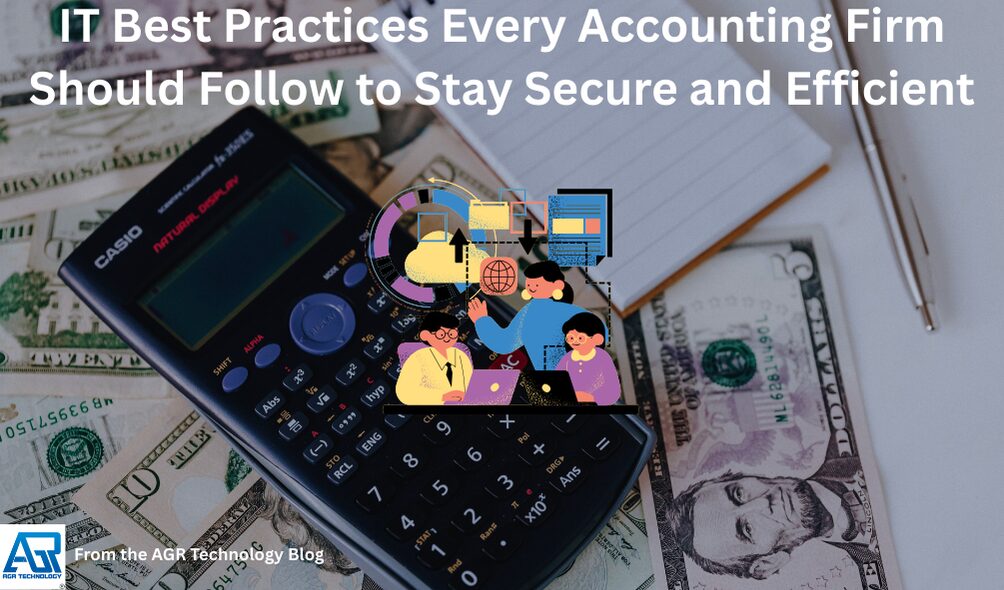Your clients trust you with their most sensitive data. A single breach, or even a slow laptop during deadline week, hurts trust, revenue, and reputation. We help accounting firms put proven IT best practices in place so teams stay secure, compliant, and fast when it matters most. Here’s what we recommend and how AGR Technology can carry out it with minimal disruption.
Need a quick starting point? Book a consultation, and we’ll map your current environment to a practical 12-month roadmap.
Governance, Compliance, and Risk Management

Establish Governance and Ownership
Security sticks when someone’s accountable. We help you formalize an IT governance model that defines who owns security, privacy, and operations across partners, finance, and IT (internal or outsourced). Clear RACI, meeting cadence, and approval workflows keep priorities moving.
- Define a security owner (CISO/vCISO) and tech owner (IT manager/MSP)
- Create an InfoSec committee with monthly reporting to partners
- Maintain an asset inventory (endpoints, servers, SaaS, data stores)
Engage AGR Technology as your virtual CIO/vCISO to run governance and keep initiatives on track.
Map to Frameworks and Regulations
Accounting firms intersect with multiple obligations. We align controls to recognized frameworks to reduce audit fatigue and satisfy clients’ vendor reviews:
- NIST CSF, ISO 27001, SOC 2, CIS Controls
- IRS Publication 4557 (safeguarding taxpayer data), GLBA, PCI DSS (if taking cards), GDPR/CCPA (if applicable)
We can map your controls to a single “control register” so you can show due diligence without reinventing the wheel.
Conduct Annual Risk and Gap Assessments
We run annual risk and gap assessments covering threat exposure, control maturity, and business impact. That includes vulnerability scans, configuration reviews, and third‑party risk.
Deliverables you can use with clients and insurers:
- Risk register with likelihood/impact
- Prioritized remediation plan and timelines
- Executive briefing for partners
Define Metrics, Roadmaps, and Budgeting
You can’t manage what you don’t measure. We set KPIs that matter to accounting firms:
- Patch compliance %, MFA coverage, phishing failure rate
- Recovery time objectives (RTO) test results
- Mean time to detect/respond (MTTD/MTTR)
Zero-Trust Controls for Client Data
Identity and Access Management
Identity is the new perimeter. We carry out zero‑trust access backed by:
- SSO + MFA for all users and admins (Microsoft Entra ID/Azure AD or Google Workspace)
- Conditional Access and least privilege, including Privileged Access Management (PAM)
- Just‑in‑time admin elevation and session recording
- Quarterly access reviews tied to your joiner‑mover‑leaver process
Result: Only the right people get the right access at the right time.
Endpoint and Patch Management
Endpoints are prime targets during tax season. We standardize and harden:
- EDR/XDR on all devices, with device encryption and screen‑lock policies
- Automated OS and app patching, with maintenance windows
- Mobile device management (MDM) for laptops/phones, with device compliance checks
We provide real‑time compliance dashboards so partners can see risk at a glance.
Network and Email Security
Email is still the #1 attack path.
- Advanced phishing protection, sandboxing, and impersonation defense
- SPF, DKIM, and DMARC enforcement to reduce spoofing
- DNS filtering and web isolation for risky sites
- Micro‑segmentation and ZTNA instead of flat VPN access
Data Classification, DLP, and Secure File Exchange
Keep PII where it belongs.
- Data classification and sensitivity labels in Microsoft 365/Google Workspace
- DLP policies for email, cloud storage, and endpoints
- Client portal/secure file exchange (SFTP or encrypted portals) instead of email attachments
- Encryption at rest and in transit: key management best practices
Talk to AGR Technology about a zero‑trust quick start for your firm.
Cloud, Vendors, and Remote Work
Standardize Secure Cloud Services
Fragmented tools slow teams and inflate risk. We help you standardize on secure, manageable platforms:
- Microsoft 365 or Google Workspace with unified security baselines
- Azure/AWS for line‑of‑business apps and hosted tax software
- Shared configurations: logging, backup, retention, and access policies
We also right‑size licenses so you don’t overpay.
Vendor Due Diligence, Contracts, and Monitoring
Your risk includes your vendors. We operationalize third‑party risk management:
- Collect and review SOC 2 Type II, ISO 27001, penetration test summaries
- Data Processing Agreements, security addendums, and SLAs (uptime, RPO/RTO)
- Continuous monitoring of vendor status changes and breach alerts
We maintain a vendor register with tiering, renewal dates, and exit plans.
Remote and BYOD Controls
Remote work isn’t going away. We secure it without killing productivity:
- Device posture checks before access (compliant, encrypted, EDR installed)
- Containerization for BYOD: prevent copy/paste to personal apps
- ZTNA over legacy VPNs: geo‑fencing and impossible‑travel alerts
Backup, Business Continuity, and Incident Response
3-2-1 Backups and Immutable Copies
Backups you can’t restore aren’t backups. We carry out the 3‑2‑1 rule with immutability:
- Three copies, two media types, one offsite
- Immutable storage (e.g., S3 Object Lock, Azure immutable), plus MFA delete
- Routine restore tests and documented results
Document Business Continuity and Disaster Recovery (RTO/RPO)
We build pragmatic BCDR plans that match how you work:
- Prioritized application inventory and dependencies
- Defined RTO/RPO for each system
- Runbooks for failover/failback, including decision trees for partners
We schedule tests outside peak filing periods and capture lessons learned.
Incident Response Playbooks and Tabletop Exercises
When minutes matter, guesswork is costly. We create IR playbooks for:
- Ransomware, Business Email Compromise, data leakage, vendor outage
- Roles, communications, legal/regulatory notification steps
- Evidence preservation and forensics support
We run tabletop exercises so your team knows who does what, before it’s real.
Align With Cyber Insurance Requirements
Carriers increasingly require specific controls. We prepare you to obtain and keep coverage:
- MFA everywhere, EDR, offline/immutable backups, email security, logging
- Documented policies, user training, vendor due diligence
- Attestation support during underwriting and renewals
- Penetration testing audits to identify vulnerabilities
Operational Excellence for Busy Seasons
Standardize the Tech Stack and Golden Images
Consistency keeps the wheels on during crunch time. We define a standard stack and golden images for laptops, VMs, and apps so onboarding is fast and predictable. No more one‑off builds.
Planned Change Windows and Rollback Procedures
We freeze risky changes during critical deadlines and use maintenance windows for updates. Every change includes a tested rollback plan and stakeholder comms to avoid surprise outages.
Monitoring, Logging, and Capacity Planning
We set up proactive monitoring so you find issues before your clients do:
- SIEM/SOC for security events
- Performance and capacity metrics for key apps, e‑filing, VPN/ZTNA, and storage
- Alert runbooks and escalation paths
Help Desk SLAs and a Living Knowledge Base
Partners and seniors need rapid help. We define SLAs for response and resolution, plus a searchable knowledge base for common tasks (new client setup, secure file share, password reset). Self‑service where it makes sense.
Ask AGR Technology about our managed IT for accounting firms.
People, Training, and Documentation
Ongoing Security Awareness and Phishing Drills
Human error is still the top risk. We deliver short, relevant training and monthly phishing simulations. We measure improvement and tailor content for tax season threats and wire fraud.
Joiner–Mover–Leaver Workflow and Access Reviews
We automate identity lifecycle so access is right‑sized:
- Pre‑hire provisioning, day‑one access, role‑based permissions
- Moves trigger access changes: leavers are deprovisioned same day
- Quarterly access recertification for privileged roles
Policy, SOP, and Evidence Management
Auditors and clients expect proof. We maintain your policy library, SOPs, and evidence (screenshots, logs, reports) in a central repository with versioning and approvals.
Data Retention, Privacy, and Legal Hold
Keep only what you need, for as long as you need it:
- Retention schedules for email, files, and backups
- Legal hold workflows and eDiscovery readiness
- Privacy notices and consent management aligned to client obligations
Conclusion
Strong IT isn’t about buying more tools, it’s about putting the right controls in the right order and keeping them running. We help accounting firms secure client data, meet compliance expectations, and keep teams productive when deadlines bite.
Next step: Request an assessment with AGR Technology. We’ll review your current state, highlight quick wins, and build a practical roadmap you can execute without disrupting billable work.
IT Best Practices for Accounting Firms: FAQs
What are the essential IT best practices for accounting firms to stay secure and efficient?
Core IT best practices for accounting firms include formal governance (CISO/vCISO ownership), annual risk and gap assessments, zero‑trust identity with SSO/MFA and least privilege, standardized patching/EDR, advanced email security and DLP, vendor due diligence, 3‑2‑1 immutable backups, tested BCDR/IR playbooks, monitored operations, and ongoing user training tailored to tax‑season threats.
How does a zero-trust model protect client data in accounting firms?
Zero‑trust limits access to what’s needed, when it’s needed. Implement SSO with MFA, Conditional Access, least privilege and PAM, just‑in‑time admin elevation, and quarterly access reviews tied to joiner‑mover‑leaver workflows. Replace flat VPNs with ZTNA and micro‑segmentation so only verified users and compliant devices reach specific apps, reducing breach impact.
What backup and disaster recovery standards should an accounting firm follow?
Follow the 3‑2‑1 rule—three copies, two media, one offsite—plus immutable storage (e.g., S3 Object Lock/Azure immutability) and MFA‑delete. Test restores regularly and document results. Define system‑level RTO/RPO, maintain prioritized application inventories, and create clear failover/failback runbooks so you can recover quickly without disrupting filing deadlines.
How should accounting firms manage vendor risk and compliance requirements?
Operationalize third‑party risk management: collect SOC 2 Type II/ISO 27001 and pen‑test summaries, require DPAs/security addendums, and define SLAs (uptime, RPO/RTO). Continuously monitor breach alerts and status changes. Maintain a tiered vendor register with renewal/exit plans. Map controls to IRS Pub 4557, GLBA, and GDPR/CCPA as applicable.
How much should an accounting firm budget for IT security and best practices?
Budgets vary by size and risk, but many firms allocate about 4–7% of revenue to IT, with 20–40% of that for security. For SMB practices, $150–250 per user/month for managed IT plus security add‑ons (EDR/MDR, email security, backup, monitoring) is common. Prioritize IT best practices for accounting firms first.
Do accounting firms need SOC 2 certification, or is aligning to a framework enough?
Most accounting firms aren’t required to obtain SOC 2 unless they operate as a service organization hosting client data or processing services for others. Many succeed by aligning controls to NIST CSF/CIS and providing evidence. Pursue SOC 2 when client demands or market positioning justify it alongside IT best practices for accounting firms.
Related content:
Cybersecurity Readiness For Business Leaders

Alessio Rigoli is the founder of AGR Technology and got his start working in the IT space originally in Education and then in the private sector helping businesses in various industries. Alessio maintains the blog and is interested in a number of different topics emerging and current such as Digital marketing, Software development, Cryptocurrency/Blockchain, Cyber security, Linux and more.
Alessio Rigoli, AGR Technology
![logo-new-23[1] logo-new-23[1]](https://cdn-ihdfn.nitrocdn.com/eZVJvoSTyVixkEUySRKiaseNtUlmgCyu/assets/images/optimized/rev-d69570f/agrtech.com.au/wp-content/uploads/elementor/thumbs/logo-new-231-qad2sqbr9f0wlvza81xod18hkirbk9apc0elfhpco4.png)
